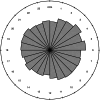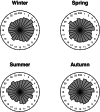The Effects of Meteorological Conditions on the Circadian Rhythm of Births
- PMID: 40772405
- PMCID: PMC12329704
- DOI: 10.1002/ajhb.70120
The Effects of Meteorological Conditions on the Circadian Rhythm of Births
Abstract
Objective: The aim of this study is to evaluate the influences exerted by temperature on the circadian rhythm of births.
Methods: In the past births occurred mainly between midnight and dawn, while today births tend to be less frequent during the night hours. Today, almost all births are hospitalized and, therefore, they may adapt to the organizational requirements of the health care structures and staff. This piece of research regards births in Udine, a city in north-eastern Italy, recorded at the beginning of the 19th century. The data on births come from the French civil register. Weather data come from very detailed daily collection with three measurements per day. From the statistical point of view, we apply methods developed for circular data. In order to highlight relationships between time of birth and explanatory variables, we estimate MANOVA (multivariate analysis of variance) models and perform a statistical test for comparison between groups.
Results: The test against the homogeneity of the hour-of-birth distributions across the 4 seasons is significant (p < 0.01). One-to-one comparison of the distributions is performed via Watson's two-sample test on data for each couple of seasons: the Summer-Autumn comparison is the only non-significant test of homogeneity. Moreover, we consider daily temperatures in the bivariate model in several different ways and transformations. The daily temperature effect is more significant if considered as the difference between the evening temperature of the day before the birth and the mean daily temperature of the same day, over the nine-year period 1807-1815. Finally, based on this division of the births, Watson's two-sample homogeneity test for the distribution of the hour of birth is significant (p < 0.05).
Conclusions: We found that the circadian rhythm of births is influenced by temperature, with an anticipation of the time of birth on warmer days. To our knowledge, our results are the first evidence of the effects of daily temperature on the time of birth.
Keywords: 19th century; North‐Eastern Italy; births; circadian rhythm; weather.
© 2025 The Author(s). American Journal of Human Biology published by Wiley Periodicals LLC.
Conflict of interest statement
The authors declare no conflicts of interest.
Figures
Similar articles
-
The Black Book of Psychotropic Dosing and Monitoring.Psychopharmacol Bull. 2024 Jul 8;54(3):8-59. Psychopharmacol Bull. 2024. PMID: 38993656 Free PMC article. Review.
-
Antioxidants for male subfertility.Cochrane Database Syst Rev. 2014;(12):CD007411. doi: 10.1002/14651858.CD007411.pub3. Epub 2014 Dec 15. Cochrane Database Syst Rev. 2014. Update in: Cochrane Database Syst Rev. 2019 Mar 14;3:CD007411. doi: 10.1002/14651858.CD007411.pub4. PMID: 25504418 Updated.
-
Sexual Harassment and Prevention Training.2024 Mar 29. In: StatPearls [Internet]. Treasure Island (FL): StatPearls Publishing; 2025 Jan–. 2024 Mar 29. In: StatPearls [Internet]. Treasure Island (FL): StatPearls Publishing; 2025 Jan–. PMID: 36508513 Free Books & Documents.
-
Non-clinical interventions for reducing unnecessary caesarean section.Cochrane Database Syst Rev. 2018 Sep 28;9(9):CD005528. doi: 10.1002/14651858.CD005528.pub3. Cochrane Database Syst Rev. 2018. PMID: 30264405 Free PMC article.
-
Antioxidants for male subfertility.Cochrane Database Syst Rev. 2022 May 4;5(5):CD007411. doi: 10.1002/14651858.CD007411.pub5. Cochrane Database Syst Rev. 2022. PMID: 35506389 Free PMC article.
References
-
- Berlinski, M. 1834. Nascentium Morientiunque Numero Ex Lege Naturae Diversis Diei Temporibus. Herrmann.
-
- Casper, J. L. 1846. “Der Einfluss der Tageszeiten auf Geburt und Tod der Menschen.” In Denkwürdigkeiten Zur Medicinischen Statistik und Staatsarzneikunde, edited by Casper J. L., 217–248. Duncker und Humblot.
MeSH terms
LinkOut - more resources
Full Text Sources
Miscellaneous





